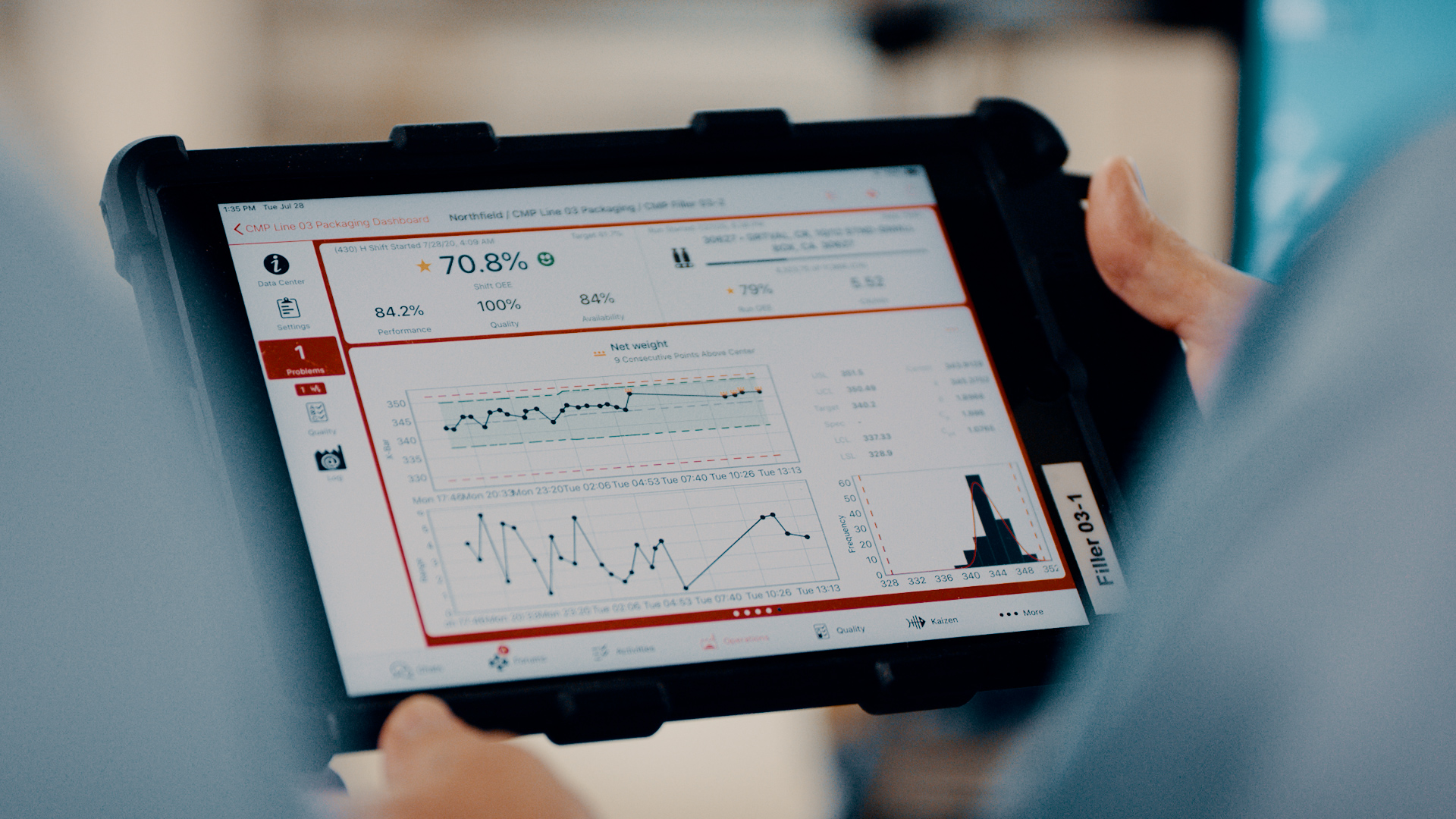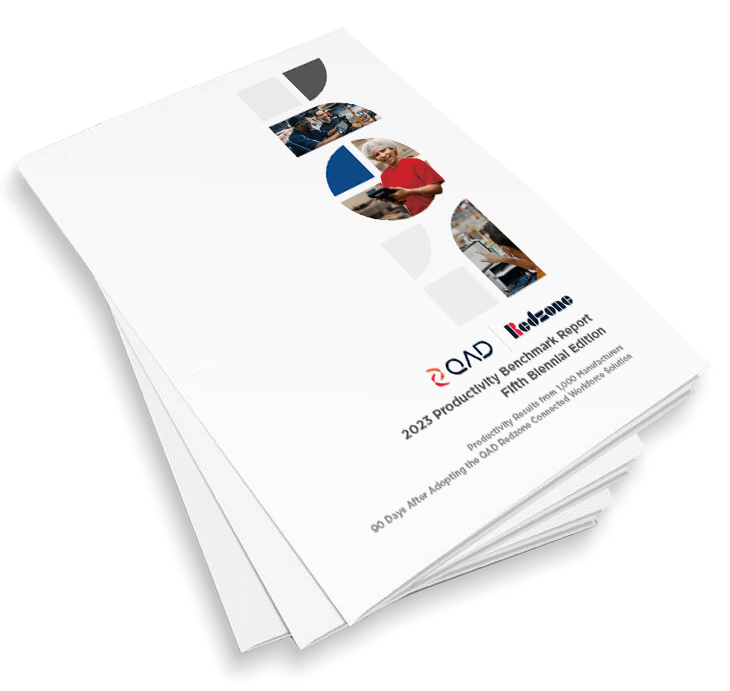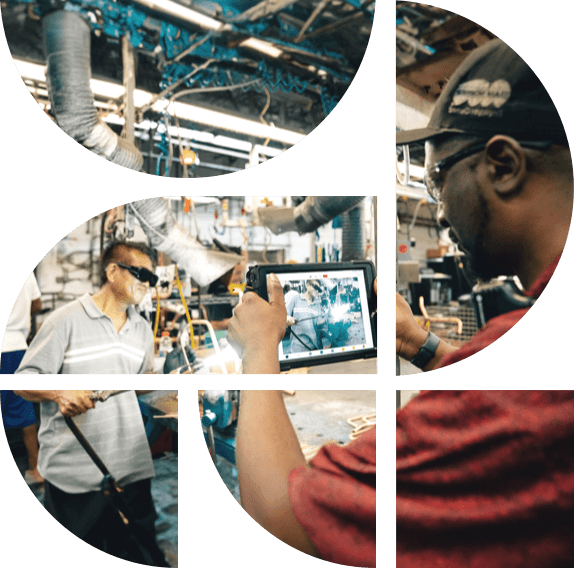Descubre las inspiradoras historias de los Rostros de la primera línea: ¡Las estrellas de la fabricación! Leer más
John Ponte
May 15, 2025

In manufacturing and other process-driven industries, ISO compliance isn’t just a badge of honor—it’s a business essential. Stringent regulations, growing cybersecurity threats, and increasing market expectations for reliable products and services have made compliance a focal point in any business environment. This is highlighted by the rapid growth of the regulatory compliance market, which reached $21.16 billion in 2024 and is set to reach almost $33 billion by 2029.
Developed by the International Organization for Standardization (ISO), the ISO compliance standards give organizations a shared framework for managing quality, safety, and operational efficiency. In this context, compliance isn’t only about passing audits or collecting certifications. It’s about instilling consistency and discipline across every level of your organization—from the C-suite to the shop floor.
For manufacturers, achieving ISO compliance can mean smoother audits, fewer disruptions, and a stronger reputation with customers, suppliers, and regulators. It also gives stakeholders the much-needed reassurance that your operations are built on trust, traceability, and a culture of continuous improvement. In a world where one weak link can slow an entire supply chain, that kind of assurance can be a major differentiator.
In this article, we look at different ISO standards and how businesses can drive compliance by using dedicated technology to improve real-time monitoring, production consistency, and overall business performance. We discuss how integrating such technology into your compliance processes can help you meet regulatory requirements and drive long-term gains for your business.
Compliance standards are a relative novelty in the world of production and manufacturing. If we consider that the Industrial Revolution was in full swing in the 18th and 19th centuries, the International Organization for Standardization wasn’t formed until 1946—less than 100 years ago.
Since then, ISO has played a crucial role in shaping global standards to ensure quality, safety, and interoperability across industries. As a non-governmental organization with members from over 170 countries, ISO provides a platform for developing and harmonizing standards that support international trade and drive innovation. For organizations, aligning with ISO standards can be a strategic move to improve their credibility and customer trust, while for customers, it’s a trustworthy stamp of approval that the products they buy meet the highest quality standards.
Since its creation, ISO has been the global authority on standardization, setting the benchmark for how products, services, and systems should operate. With its rigorous development process involving technical experts and industry stakeholders across geographies, ISO has created over 25,000 compliance standards to date on anything from safety to reliability, underlining its integral influence on global commerce and public safety.
These standards aren’t just a nice-to-have, though. Data shows that companies who implement ISO 9001 see an improvement in employee and customer-related company performance. Manufacturers with this certification also report a 15% increase in business opportunities within a year of obtaining it.
ISO’s authority is further cemented by its continuous adaptation to emerging challenges. The recent enhancements to standards like ISO 27001, focusing on cybersecurity, and ISO 14001, emphasizing environmental management, showcase ISO’s proactive stance in addressing global and technological shifts. In this sense, compliance with ISO standards often becomes a key differentiator, signaling your organization’s commitment to excellence and continuous improvement.
The ISO compliance standards encompass virtually every sector imaginable—from aerospace engineering and medical device manufacturing to food safety, data privacy, and even sustainable tourism. Each standard is designed to streamline processes, reduce errors, and foster interoperability between systems, products, and services across borders.
This vast library of standards serves as a universal language for organizations and regulators alike, shaping the way companies operate and interact in a globalized economy. Whether it’s ISO 9001 for quality management, ISO 27001 for information security, or ISO 14001 for environmental management, each standard serves a specific purpose while collectively promoting consistency and accountability.
The true power of ISO standards, however, lies in their ability to create trust and consistency at scale. In international trade, ISO-compliant products and services are more easily accepted by regulators and consumers, reducing barriers to market entry. In procurement, companies often require ISO certifications as a prerequisite for partnerships, knowing they signal a baseline of quality, safety, and reliability. Even within organizations, ISO standards act as a governance tool—aligning departments, guiding risk management, and supporting long-term strategic planning.
Let’s take a look at specific standards and their impact on business operations.
In a time when cyberattacks and data breaches dominate headlines, ISO 27001 has become the benchmark for information security. This standard sets out the criteria for establishing, implementing, maintaining, and continually improving your organization’s Information Security Management System (ISMS). It takes a risk-based approach, requiring organizations to identify potential threats, assess vulnerabilities, and apply specific measures to mitigate risk.
Companies that have adopted ISO 27001 demonstrate an ongoing commitment to safeguarding user data. Dropbox, for example, earned ISO 27001 certification for its core file storage infrastructure, business platform, and Paper product. The company implemented strict access controls, regular risk assessments, and continuous monitoring to meet the standard’s rigorous security requirements—ensuring customer data is protected at every level.
This certification not only enhances internal risk management but also builds trust with clients and partners—particularly in sectors like finance, healthcare, and cloud computing, where data sensitivity is paramount.
ISO 9001 remains one of the most recognized and widely used standards in the world. It provides a structured framework for establishing a Quality Management System (QMS), ensuring that organizations consistently deliver products and services that meet customer and regulatory requirements. As of 2025, ISO 9001 has been implemented by over a million organizations across 190 countries—a testament to its global relevance and adaptability.
The framework focuses on core principles like customer centricity, leadership, engagement of people, workflow optimization, and continual improvement. The standard requires organizations to:
While ISO 9001 is applicable to any industry, its emphasis on documented procedures, risk-based thinking, and internal audits makes it especially valuable in sectors where process reliability is critical—such as manufacturing, healthcare, and logistics.
Workplace safety is both a legal obligation and a moral imperative. ISO 45001 provides a framework for organizations to proactively manage occupational health and safety (OH&S) risks and opportunities. This standard helps identify potential hazards, assess risks, and implement measures to prevent work-related injuries and illnesses.
Unlike older safety frameworks that were often reactive, ISO 45001 promotes a preventive, systems-based approach. The standard integrates seamlessly with other ISO management systems and is relevant across all industries—from construction and manufacturing to healthcare and public services. Statistics show that businesses that adopt this standard in their safety management system can decrease workplace accident rates by 22.6%.
By implementing ISO 45001, organizations not only comply with regulations but also demonstrate a commitment to employee well-being, reducing absenteeism, insurance costs, and liability risks—helping the business stand out both as a service provider and an employer.
As environmental concerns become more pressing, ISO 14001 helps businesses play a proactive role in driving sustainability. This standard outlines the requirements for an effective Environmental Management System (EMS), enabling organizations to control their environmental impact, comply with regulations, and improve overall environmental performance.
ISO 14001 is applicable to organizations of all sizes and sectors. It provides a framework for setting environmental goals, assessing impacts, and integrating sustainable practices into business strategies. Key aspects include reducing waste, lowering energy consumption, and improving supply chain emissions management.
The standard also guides businesses in setting environmental objectives and integrating sustainability into their strategic planning. In an era of ESG (Environmental, Social, and Governance) reporting, ISO 14001 has become a valuable asset for demonstrating green credentials to investors, customers, and regulators.
For companies in the medical device industry, compliance is a must. ISO 13485 specifies requirements for a quality management system relevant for medical device manufacturing, while ISO 14971 focuses on the application of risk management throughout the lifecycle of medical devices. Specifically, ISO 13485 emphasizes regulatory compliance, traceability, and validation processes, while ISO 14971 addresses risk analysis, evaluation, control, and monitoring. Together, these standards ensure that medical devices are safe, effective, and consistently manufactured to high quality.
Compliance with these standards is also a key requirement for regulatory approval in major global markets. For example, ISO 13485 certification is aligned with the EU’s Medical Device Regulation (MDR) and is recognized by Health Canada and the Pharmaceuticals and Medical Devices Agency (PMDA) in Japan. Currently, over 33,000 organizations worldwide are certified to ISO 13485, reflecting its critical role in market access and patient safety.
Obtaining an ISO compliance certification is a rigorous, standards-based process that checks and validates specific systems within an organization. It requires businesses to prove—not just claim—that their systems, processes, and controls meet ISO’s stringent international standards.
The process of becoming ISO certified follows these six steps:
Organizations that go through the ISO certification process often experience measurable performance improvements beyond compliance.
Operationally, ISO-certified companies report improved consistency, reduced process variation, and fewer quality incidents. For example, manufacturers adopting ISO 9001 frequently see a drop in rework and scrap rates, while IT service providers using ISO 27001 are better equipped to prevent data breaches and respond to incidents swiftly. Standardized documentation and clear process ownership also enable smoother onboarding, faster troubleshooting, and better cross-functional collaboration.
Financially, the return on ISO implementation can be significant. Cost savings often arise from reduced errors, improved resource utilization, less downtime, and more efficient supply chain management. ISO 14001, for instance, helps companies cut energy consumption and waste disposal costs, while ISO 45001 can lower the frequency of workplace incidents, reducing insurance premiums and lost workdays.
In the automotive sector, the total gross profit contribution of standards across core business functions—engineering, procurement, and production—has been estimated at 1.3% to 1.8% of total sales, highlighting the tangible financial value that ISO standards can deliver across high-performance industries.
Finally, certification enhances marketability. Many procurement teams, especially in regulated industries or multinational supply chains, require ISO certification as a basic entry criterion. Certified companies are better positioned to win tenders, enter new markets, and build long-term client relationships based on credibility and transparency.
As ISO standards become more commonplace, organizations are increasingly turning to digital tools to streamline processes and drive compliance. Manual tracking and siloed spreadsheets can no longer keep pace with scaling operations or the various industry regulations. Modern compliance management software offers a scalable, integrated solution, helping teams track requirements, manage documentation, and ensure ongoing alignment with ISO standards.
Compliance management platforms are purpose-built to support compliance with a range of ISO frameworks. These systems offer a centralized, structured environment for organizing and controlling essential compliance elements such as policy documents, standard operating procedures (SOPs), training records, and audit logs. They also simplify the management of risk registers, corrective and preventive actions (CAPA), and non-conformity tracking—all critical components for maintaining your certification.
Two of the most valuable features of compliance management software are version control and change tracking. Any updates to documentation or processes are logged automatically, ensuring the traceability and accountability needed for recertification. Built-in workflows and automated reminders also help teams stay on top of deadlines, mitigating the risk of missed reviews or lapses in compliance activities.
By centralizing data and providing real-time visibility across departments, these platforms reduce human error, improve collaboration, and make it easier to demonstrate compliance to external auditors.
Going beyond digitization, cloud-based tools add another layer of efficiency by enabling remote access, automated workflows, and real-time reporting. These systems support key ISO compliance activities such as:
For distributed teams or organizations undergoing rapid growth, cloud-native tools provide the flexibility and control needed to scale compliance efforts without sacrificing rigor.
Redzone brings a unique advantage to ISO compliance by bridging the gap between the factory floor and compliance frameworks. As the #1 connected workforce solution, Redzone enables frontline teams to engage directly with compliance processes—whether it’s logging audit data, following standardized work instructions, or executing corrective actions in real time.
Through intuitive mobile interfaces and real-time data capture, Redzone ensures that compliance isn’t an afterthought—it’s built into the rhythm of daily operations. This not only supports alignment with ISO standards like 9001 and 45001 but also reinforces a culture of accountability and continuous improvement at every level of the organization.
Some of its key features built for compliance include:
Risk management is inherently embedded within the DNA of modern quality standards. Nearly every ISO framework, from information security to quality and occupational health, emphasizes proactive risk identification, evaluation, and mitigation.
ISO 31000, in particular, provides the overarching framework that organizations need to systematize and strengthen their risk management capabilities, making it a cornerstone of long-term compliance and resilience.
ISO 31000 is the international standard for risk management, offering a comprehensive, principles-based approach to identifying, assessing, and addressing risks across all areas of an organization. Rather than prescribing a one-size-fits-all method, ISO 31000 provides a flexible structure that can be adapted to various contexts—whether for regulatory risk, operational risk, or strategic uncertainty.
At its core, the standard encourages organizations to embed risk thinking into decision-making processes and integrate it with other management systems, including ISO 9001, ISO 27001, and ISO 45001. Key components include:
While compliance is a key benefit of ISO 31000, an even greater advantage is the resilience it builds against future disruptions—an increasingly critical capability in volatile business environments.
Embedding risk management into your ISO compliance efforts helps create a sustainable system for anticipating and responding to issues before they escalate. This is particularly important for standards like ISO 27001 (which mandates risk assessments as part of the ISMS) and ISO 45001 (which focuses on workplace hazards and controls).
A mature risk management approach supports compliance by:
Ultimately, effective risk management enhances operational visibility, supports leadership decision-making, and ensures compliance is not a static goal but an evolving practice.
Achieving ISO certification is not just about passing an audit—it’s about building the systems, culture, and capabilities that position your organization for long-term success. From process standardization and data security to workplace safety and environmental responsibility, ISO standards create a foundation for trust, efficiency, and competitive advantage.
Throughout this article, we’ve explored how organizations can leverage various ISO frameworks to drive meaningful improvements across their business. We’ve also examined the growing role of technology in simplifying and sustaining compliance—from cloud-based documentation and training tools to integrated risk management platforms.
QAD Redzone stands out by connecting these best practices to the front lines of your operation. As the #1 connected workforce solution, it empowers teams to engage directly in compliance activities—capturing data, executing corrective actions, and maintaining audit readiness in real time. For organizations looking to reduce risk, boost productivity, and maintain certification with less friction, Redzone offers a practical, scalable solution.
Tired of chasing paperwork, scrambling before audits, or relying on gut feel to spot quality issues? Book a demo and see how Redzone helps manufacturers embed ISO compliance into daily operations—all without slowing down production.
From real-time quality checks to paperless audits, Redzone empowers your frontline and strengthens your bottom line every single day.
John Ponte John is QAD Redzone’s Senior Director of Growth Marketing and brings a background of over 20 years in B2B Software. He is responsible for setting the growth strategy and driving global demand generation strategies to boost pipeline, new customer acquisition, and create expansion opportunities. When John’s not tracking Marketing and business targets, you can find him playing tennis, and even officiating as a national umpire and referee, working with local charities he supports, and enjoying time with family.
Datos de productividad de 1000 fábricas: El mayor conjunto de datos d...

Ponte en contacto con nosotros y comencemos a empoderar a tu primera línea y a aumentar tus ganancias.
